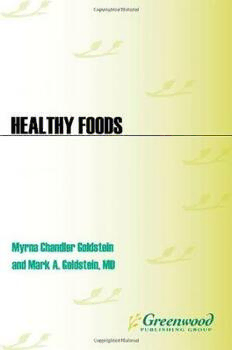
Healthy Foods: Fact Versus Fiction PDF
Preview Healthy Foods: Fact Versus Fiction
HEALTHY FOODS This page intentionally left blank HEALTHY FOODS Fact versus Fiction Myrna Chandler Goldstein and Mark A. Goldstein, MD Copyright2010byMyrnaChandlerGoldsteinandMarkA.Goldstein,MD Allrightsreserved.Nopartofthispublicationmaybereproduced, storedinaretrievalsystem,ortransmitted,inanyformorbyany means,electronic,mechanical,photocopying,recording,orotherwise, exceptfortheinclusionofbriefquotationsinareview,withoutprior permissioninwritingfromthepublisher. LibraryofCongressCataloging-in-PublicationData Goldstein,MyrnaChandler,1948– Healthyfoods:factversusfiction/MyrnaChandlerGoldstein andMarkA.Goldstein. p.cm. Includesbibliographicalreferencesandindex. ISBN 978-0-313-38096-9 (hard copy : alk. paper)—ISBN 978-0-313-38097-6 (ebook)1.Food.2.Nutrition.I.Goldstein,MarkA.(MarkAllan),1947–II.Title. TX355.G672010 641.3—dc22 2010013684 ISBN:978-0-313-38096-9 EISBN:978-0-313-38097-6 14 13 12 11 10 1 2 3 4 5 ThisbookisalsoavailableontheWorldWideWebasaneBook. Visitwww.abc-clio.comfordetails. GreenwoodPress AnImprintofABC-CLIO,LLC ABC-CLIO,LLC 130CremonaDrive,P.O.Box1911 SantaBarbara,California93116-1911 Thisbookisprintedonacid-freepaper ManufacturedintheUnitedStatesofAmerica CopyrightAcknowledgments AllphotographsarecourtesyofMarkA.Goldstein,MD. CONTENTS Introduction vii Almonds 1 Apples 7 Avocados 13 Bananas 19 Barley 25 Bell Peppers 31 Black Beans 37 Blueberries 43 Brazil Nuts 49 Broccoli 55 Buckwheat 61 Cabbage 67 Capers 73 Carrots 79 Celery 85 Cherries 91 Chickpeas 97 Chocolate 103 Cranberries 109 Dried Plums 115 Eggs 121 vi CONTENTS Flaxseeds 127 Garlic 133 Ginger 139 Grapefruit 145 Grapes 151 Kale 157 Kiwis 163 Lemons andLimes 169 Lentils 175 Macadamia Nuts 181 Mushrooms 187 Oats 193 Olive Oil 199 Onions 205 Oranges 211 Pears 217 Pineapples 223 Pomegranates 229 Pumpkins 235 Sardines 241 Sea Vegetables 247 Sesame Seeds 253 Soy 259 Spinach 265 Sunflower Seeds 271 Tea 277 Tomatoes 283 Turnips 289 Walnuts 295 Glossary 301 Index 305 INTRODUCTION Every day, consumers are bombarded with information about food. Wher- ever they go and whatever they do, consumers are confronted with a never- ending commentary on the topic. And, all too often, the material that is presented may be heralded one day and denounced the next. Dietitians and nutritionists may sing endless praises for certain foods; later, consumers may be advised to eliminate these same foods from their diets. For example, for years, all fats were lumped together in one giant pot. People were told to reduce or eliminate fat from their diets. It is now recognized that some fats, such asolive oil,may play anintegral role in a healthful diet. The goal of this book is to investigate the research behind some 50 sup- posedly healthful foods. In many cases, that is relatively easy. There are a number of foods that have been extensively studied. But, that is not true for some supposedly healthful foods. In numerous instances, we were unable to locate a sufficient amount of research to write an entry. Moreover, there are about a dozen healthier foods that are grown with large amounts of pes- ticides. It is our belief that the benefits obtained from eating those foods may well be compromised by the pesticides. (Those consumers who wish to reduce their intake of pesticides should purchase the organically grown ver- sions of those foods.) It is also important to realize that even truly beneficial foods should be eaten as part of an overall wholesome and nourishing diet. Thus, though blueberries are a superb addition to the diet, no one would advise people to eat them three times a day. It is especially important not to eat large amounts of dried fruit, with their concentrations of sugar. And, while the consumption of organic apples strongly supports good health, they will do very little toassist a daily lunch of pizza anda bag ofchips. For most people, their diet should consist primarily of fruits, vegetables, beans, legumes, nuts, seeds, and whole grains. However, their diet should also include lean protein obtained from lean poultry, cold-water fish (such as sardines, halibut, and wild salmon), and tofu, and healthier fatty foods, viii INTRODUCTION such as olive oil, sesame seeds, and avocados. Foods with saturated fat, such as red meat, should be consumed sparingly. Sometimes, it is advantageous to eliminate them from the diet. In fact, many vegans, people who eat no animal products, report improvements in their health and well-being and a greater easein maintaining a healthful weight. At present, about two-thirds of Americans are overweight or obese. These conditions are associated with other medical problems such as diabe- tes, cancer, and cardiovascular disease. If more Americans could find ways to include greater amounts of healthier foods in their diets, the prevalence of these illnesses could be reduced. We hope that this book plays a role in that undertaking. ALMONDS Although thevastmajorityofpeopleviewalmondsasatypeofnut,techni- cally, they are not. In fact, almonds are actually the seeds of the fruit of the almond tree, a mid-sized tree that has aromatic pink and white flowers. There are two types of almonds: sweet and bitter. Only the sweet are eaten; bitter almonds are used to make almond oil. Believed to have originated in North Africa and western Asia, almonds havebeengrownforthousandsofyears.TheyareevenmentionedintheBible. Today,almondsflourishincountriesthatbordertheMediterraneanSea,such asSpainandItaly.IntheUnitedStates,theyaregrowninCalifornia.1 Known to be high in fat, almonds have been shunned by some people concerned about weight gain. Isthat a wise choice?
